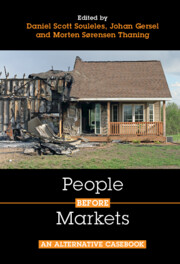Book contents
- People Before Markets
- People Before Markets
- Copyright page
- Dedication
- Contents
- Contents by Topic
- Authors
- 1 Introduction: Why Are You Here?
- 2 Some Philosophical Help with “Neoliberalism”
- Part I Our World
- Part II Our Lives
- Part III Our Work
- 18 What Should a Job Look Like?
- 19 How Should Innovation Work?
- 20 Who Should Get Investment Capital?
- 21 Who Should Own a Business?
- 22 How Should the Government Decide from Whom to Buy Stuff?
- Index
22 - How Should the Government Decide from Whom to Buy Stuff?
from Part III - Our Work
Published online by Cambridge University Press: 27 October 2022
- People Before Markets
- People Before Markets
- Copyright page
- Dedication
- Contents
- Contents by Topic
- Authors
- 1 Introduction: Why Are You Here?
- 2 Some Philosophical Help with “Neoliberalism”
- Part I Our World
- Part II Our Lives
- Part III Our Work
- 18 What Should a Job Look Like?
- 19 How Should Innovation Work?
- 20 Who Should Get Investment Capital?
- 21 Who Should Own a Business?
- 22 How Should the Government Decide from Whom to Buy Stuff?
- Index
Summary
As we noted in our Introduction, one thing that distinguishes neoliberalism from plain old liberalism was the recognition that the state was necessary to allow market-based activities to occur. There needed to be regulatory and judicial guardrails that allowed for and even encouraged market activity. That said, this conception of the state was meant to indicate that the state creates an arena for market life to happen, not that the state should become a consumer. However, an unfortunate reality of life for neoliberal thinkers is that the state is often an outsized participants in markets. Moreover, the state often attempts to exercise its values (say, reducing greenhouse emissions) in the consumption choices that it makes. Consuming with values in mind is particularly complicated when you have a state and international organizations set up to allow neoliberal market arenas. This chapter attempts to capture just how complicated and confusing this situation can be by hearing about Groot’s experience managing government procurement in an EU nation. What quickly becomes apparent is how vertigo-inducing the whole exercise is, and how easy it is to get carried away by various institutional constraints and priorities that often don’t make much sense. Rather than presenting a viable contrast case, this chapter provides a view from the inside of one our eras biggest market actors, the state.
Keywords
- Type
- Chapter
- Information
- People before MarketsAn Alternative Casebook, pp. 463 - 473Publisher: Cambridge University PressPrint publication year: 2022



